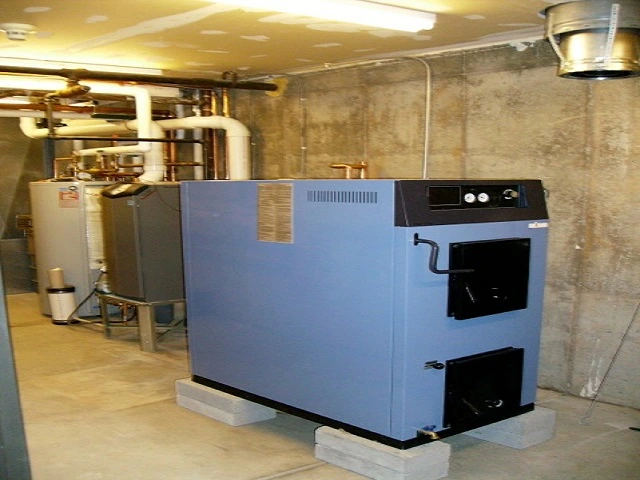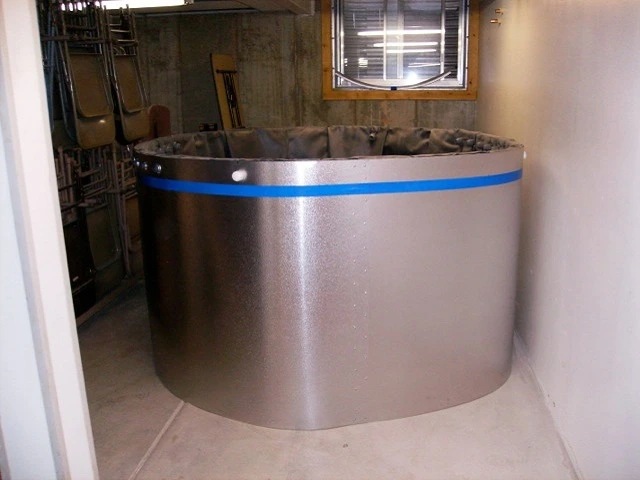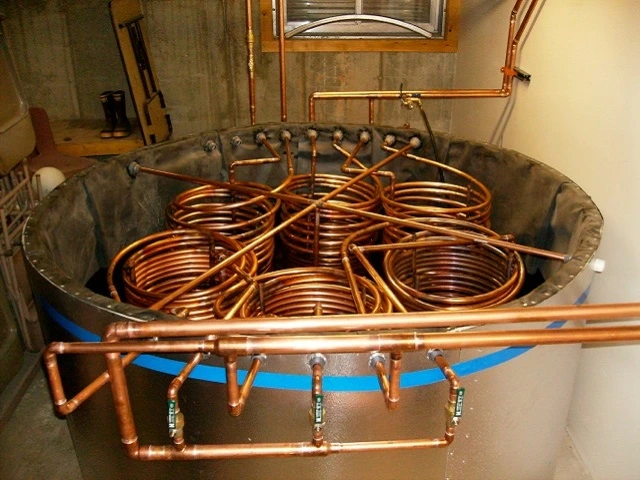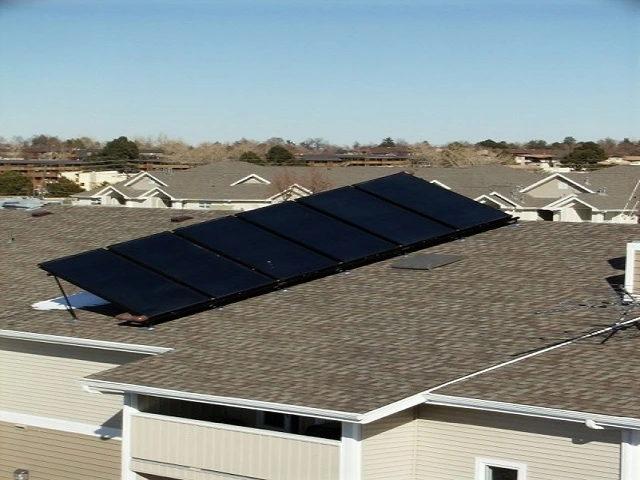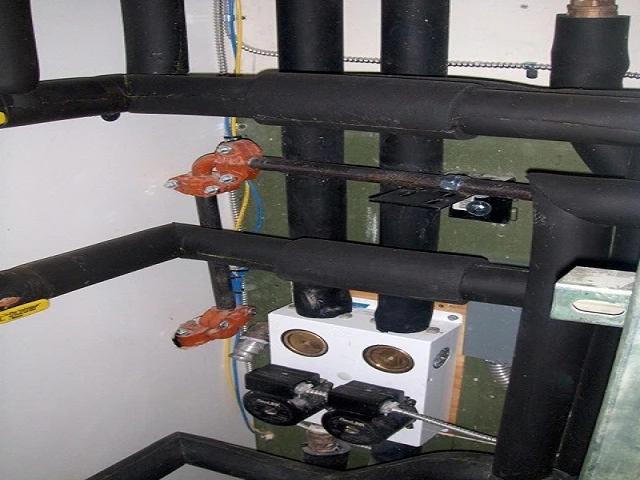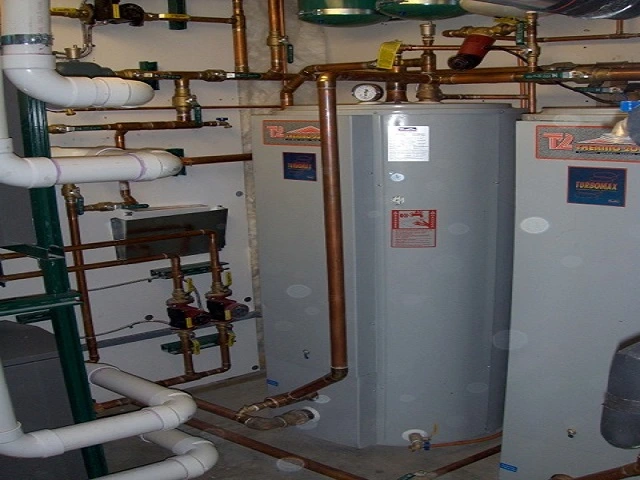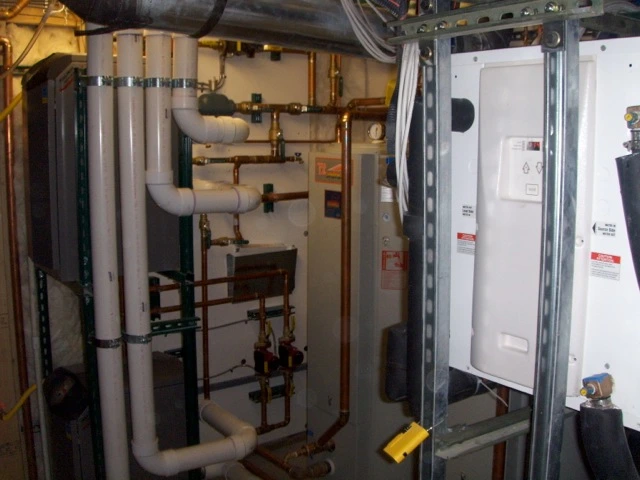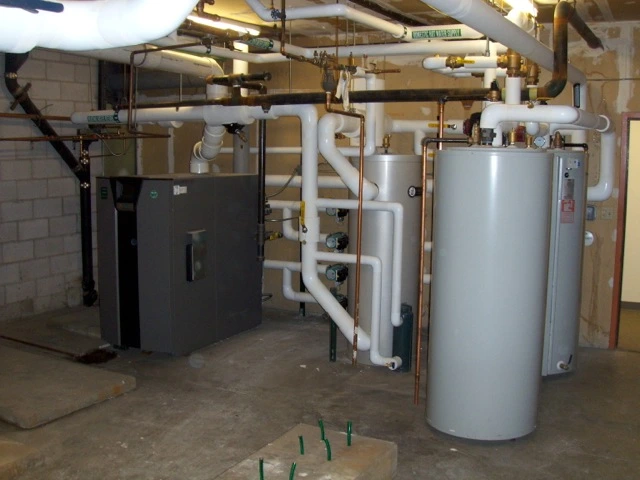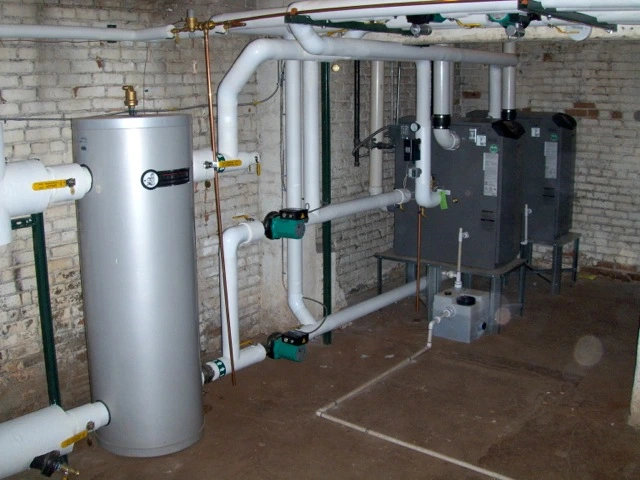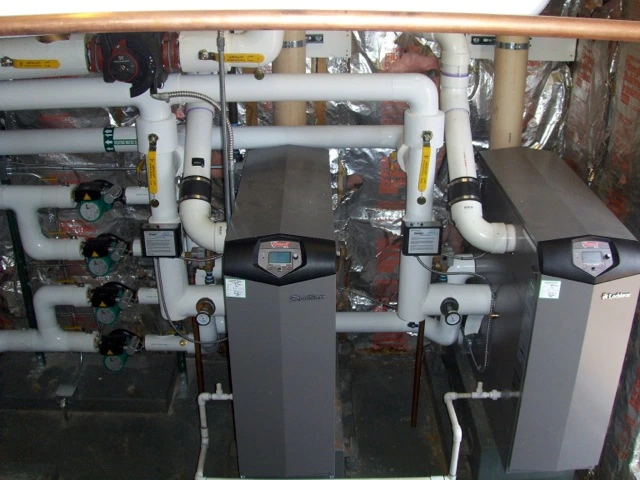Green Energy
Help the Environment with a Hydronic Green Energy SystemUnderstanding Ground Source and Geo-Exchange Systems
Ground source and geo-exchange systems capitalize on the consistent temperature differential between the Earth’s mean temperature and the outside air temperature. The Earth naturally absorbs and stores heat from the sun. During the heating season, a heat pump extracts this stored heat from the ground and distributes it throughout a building, either via radiant floor systems or forced-air systems. In the cooling season, the process is reversed; the system extracts heat from the building and transfers it back into the earth.
In our specific area, implementing this system involves drilling several 4 7/8″ diameter holes to depths ranging from 175 to 225 feet. The exact number of holes depends mainly on the size of the building being served.
Pipes, containing a mixture of water and an antifreeze, are looped down and up each hole, and then everything is sealed with a grout similar to that used in oil or natural gas drilling. The system is closed, meaning that the liquid remains within the system; with no substances being removed from or added to the Earth aside from heat.
The liquid is pumped through these pipes into the building, where the heat exchange process takes place. The tops of these drilled holes are generally located about 6 feet below the surface, and all manifolds and connecting pipes are buried underground. The loop fields (the drilled holes and piping) require no maintenance and have a life expectancy of at least 50 to 100 years.
Is Ground Source/Geo-Exchange Technology New?
Geo-exchange technology is not a new concept. Albert Einstein used this technology to heat and cool his home in New Jersey in the 1920s. Although it was not widely adopted until about 1980, it has since gained traction and is now effectively utilized in both commercial and residential applications.
Today, there are hundreds of thousands of such systems installed across the United States. Given the increasing energy prices, concerns over energy supply, and the imperative to protect our environment, geo-exchange technology presents a highly attractive solution for modern heating and cooling needs.
Solar Hot Water Systems: Harnessing the Power of the Sun
Solar hot water systems (SHW) are designed to harness sunlight,converting it into heat that is then transferred via a fluid to solar collectors mounted on your roof. This heat is subsequently used to warm the water in your home, significantly reducing the energy demand on your conventional water heater by up to 50 to 80 percent, which translates into substantial savings on your energy bills.
The operation of solar hot water systems is straightforward. In a conventional water heater, every time you use hot water, cold water enters the heater to replace the used amount, and the heating process begins anew. In contrast, a solar hot water system uses preheated water from the solar storage tank to refill the main water heater tank. This preheated water is often at a higher temperature, resulting is less energy needed to heat it to the desired level. Consequently, you enjoy reduced energy consumption and a reliable supply of hot water.
Versatility of Solar Hot Water Systems
Solar hot waters systems can also extend their benefits beyond just heating water for household use. The heat generated can also be utilized for:
- Heating a pool or spa: Providing an eco-friendly way to maintain comfortable water temperatures.
- Heating your home: Contributing to space heating, thus lowering your overall energy costs.
A well-installed solar hot water system requires minimal maintenance and can have an expected lifespan exceeding 20 years. Furthermore, a single hot water system can offset about 40% of the carbon dioxide emissions produced by a typical a car, making it an environmentally friendly option.
Types of Solar Hot Water Systems
When exploring solar heating systems, you may encounter various terms such as:
- Closed-loop antifreeze systems: These systems circulate a non-freezing liquid through the solar collectors and a heat exchanger.
- Drain-Down systems: Designed to drain the fluid from the collectors when the system is not in use, preventing freezing or overheating.
- Drain-back systems: Similar to drain-down systems but use gravity to drain the fluid back into a reservoir.
- Recirculation systems: These systems circulate the water directly through the solar collectors and the storage tank.
- Domestic hot water (DHW) systems: Also known as solar domestic hot water (SDHW) systems, specifically designed for heating water for household use.
- Space heating systems: These systems integrate with your home’s heating system to provide additional heat.
Selecting the appropriate system for your needs depends on numerous factors, including your location, climate, and specific household requirements. We specialize in designing systems tailored to best fit your unique situation, ensuring optimal efficiency and performance.
By investing in a solar hot water system, you not only save on energy costs but also contribute to a greener planet by reducing your carbon footprint.
Additional Green Energy Facts
Energy Costs and Savings
- According to the Environmental Protection Agency, geo-exchange systems are the most energy-efficient, environmentally friendly, and cost-effective space conditioning systems available.
- Geo-exchange systems typically reduce energy costs by 25% to 50% compared to other HVAC systems.
- They lower electricity demand by nearly 1 kW per ton of capacity.
- Even in hot, humid regions with high air conditioning demands, geo-exchange systems have a lower lifecycle cost than conventional systems and boast a long equipment life of over 20 years.
- If every school district needing to replace heating and cooling systems over the next 10 years chose geo-exchange systems, the total energy savings would exceed $11 billion.
- If all eligible schools installed geo-exchange systems, the electricity savings would be enough to power one million homes for a year.
- The EPA found that geo-exchange systems can reduce energy consumption—and corresponding emissions—by over 40% compared to air-source heat pumps and by over 70% compared to electric resistance heating with standard air conditioning equipment. Combining geo-exchange with other energy-efficient measures, such as window or insulation upgrades, can further increase these savings.
Geothermal Use
- Over 650,000 geothermal heat pump units are currently installed in the U.S., resulting in an annual savings of 5.2 billion kWh, 26 trillion BTUS of fossil fuels, a reduced electricity demand by 1.7 million kW, and the elimination of nearly 4 million tons of CO2
- Those 650,000 installations are equivalent to:
- Taking 840,000 cars off the road.
- Planting 250 million trees.
- Reducing US reliance on imported fuels by 14 million barrels of crude oil per year.
Applications of Green Energy Systems
- For businesses, geo-exchange systems offer optimal design flexibility by freeing the roof and landscape from chillers, air handlers, and other outdoor equipment. Boiler rooms can be eliminated, and the size of mechanical rooms can be reduced.
- Geo-exchange systems are ideal for renovating buildings with historical significance. A successful strategy involves using smaller heat pumps dispersed in closets, basements, and attics to provide space conditioning and ventilation with minimal ducting. This approach avoids unsightly condensers on the roof or grounds, preserving the building’s historic charm.
Start Your Hydronic Project Today!
Act now! Whether you’re a homeowner seeking relief or an architect designing green solutions for a new home, Advanced Hydronics are the experts to call.
Contact us at (303) 778-7772.

